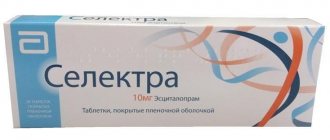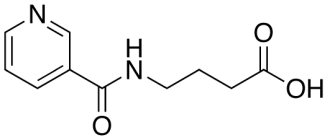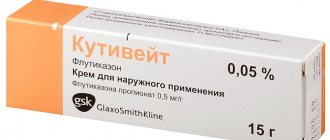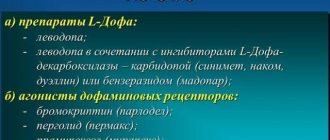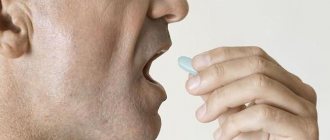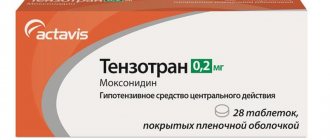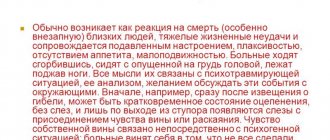Often on the pharmaceutical market there are drugs that have extremely similar active ingredients, dosages, indications and other properties. However, it is not always clear to patients why and why to copy the same medicine?
You can often find copies of original (that is, first synthesized) drugs. Such copies (or analogues) are called “generics” and are usually cheaper than the original. At the same time, it is worth honestly admitting that generics cannot always provide the same therapeutic effect as the original drug.
In the case of Mexidol and Ethoxidol, even for some medical workers it is not always clear - are they analogues, generic and original, or even the same thing? Let's look at this issue in detail.
To clearly understand the differences between the drugs, let’s look at their differences in each section of the instructions for use and draw a conclusion based on the results.
Interaction with other tools
Concomitant use of medications with medications from other groups can lead to unpredictable consequences. By reacting, they can increase or decrease the effect of the components on the body. It depends on the characteristics of the drugs:
- simultaneous use with antiepileptic medications enhances their effect;
- when conducting chemotherapy in patients with cancer, taking these drugs reduces the toxic effects;
- enhance the effect of tranquilizers, antidepressants, antipsychotics;
- reduce the effectiveness of painkillers.
In combination with ethanol, Mexidol significantly reduces the level of its negative effects. Ethoxidol enhances the mechanism of action of medications intended to treat Parkinson's disease.
During the first consultation with a specialist, you must inform about taking any medications. This information will help the doctor select the most effective and safe methods of therapy.
Indications and contraindications
Since both drugs have an identical mechanism of action, they have common indications for use. A course of treatment with these drugs is prescribed for:
- the development of pathologies caused by a lack of oxygen;
- diagnosing ischemia of the spinal muscles or brain;
- treatment of neurotic disorders;
- hangover syndrome;
- consequences after taking drugs that affect cell metabolism;
- the need to saturate the heart muscles with oxygen.
Taking these medications helps to get rid of depression or psychological disorders that arise against the background of severe emotional upheaval or frequent stress.
Like other medications, Ethoxidol and Mexidol have a number of contraindications:
- Individual intolerance to one of the substances.
- Pregnancy/lactation period.
- Children under 18 years of age.
Taking Mexidol is prohibited for patients with kidney or liver pathologies. If conception occurs during the course of treatment, the medication must be stopped. Because it can increase the risk of developing pathologies in the fetus.
Instructions for use of pills
The drug in this release form is taken orally. In this case, the person must first chew and then wash down the medicine “Ethoxidol” with water. Tablets in the amount of 1 piece are prescribed three times a day for a diagnosis such as coronary heart disease. Then the dose is gradually increased to ensure a guaranteed therapeutic effect. However, a person should know that the maximum one-time number of tablets taken should be no more than 2 pieces. And you can take no more than 8 pills per day. The course of treatment with Ethoxidol tablets should be at least 2 months, after which the doctor can make recommendations to continue therapy with this drug or to stop using it.
Applications and dosages
for adults
The tablet must be chewed and washed down with water. The dosage regimen of Ethoxidol is selected depending on the diagnosis.
For ischemic heart disease and ischemic stroke, the drug is taken 1 tablet three times a day, then the dosage is gradually increased until a therapeutic effect is obtained. The highest single dosage is 200 mg, daily dosage is 800 mg. You need to take the medicine for at least 2 months, repeated courses are possible after consultation with your doctor.
For cognitive disorders, the medication is prescribed without limiting the course of therapy in duration at a dosage of 100 mg 3-4 times a day.
In ampoules, the solution can be administered intramuscularly or by drip or stream intravenously.
If the drug is prescribed as an infusion, it should first be diluted in saline solution.
Dosages are selected individually. Treatment begins with a single dosage of 50-100 mg, the frequency of administration can vary from 1 to 3 times a day, gradually increasing until the therapeutic effect occurs.
The medicine is administered intravenously over 5-7 minutes; the drug is administered drip-wise at a rate of 40 to 60 drops per minute.
For stroke, the drug is administered intravenously in the first 2-4 days at a dosage of 200 to 300 mg, then the drug is prescribed intramuscularly at a dose of 100 mg three times a day. The duration of therapy varies from 10 to 14 days.
For decompensated dyscirculatory encephalopathy, the antioxidant is first administered intravenously at a dosage of 100 mg 2-3 times a day for 2 weeks, then the medication is administered intramuscularly at a dose of 100 mg twice a day for 14 days. To prevent this disease, the drug is administered intramuscularly at a dosage of 100 mg 2 times a day for 10-14 days.
For mild cognitive impairment in people of the older age group and for anxiety disorders, the medicine is injected into the muscle in a daily dosage of 100 to 300 for 2-4 weeks.
For withdrawal syndrome in patients suffering from alcoholism, the medicine is administered into the muscle at a dose of 100-200 mg 2 or 3 times a day or into a vein by drip 1 or 2 times a day for 5-7 days.
In case of acute intoxication with antipsychotics, the medication is administered intravenously in a daily dosage of 50 to 300 mg for 1-2 weeks.
Reviews from doctors
Grinko V.V., neurologist: “I prescribe Ethoxidol to my patients suffering from neurosis. This drug is a powerful antioxidant. For example, one patient had tremor of the fingers, increased muscle tone, and worsened attention and memory. We carried out courses of injections, injecting them twice a day into the muscle. The injections were not too painful. There were no side effects and the medicine was absorbed very well.”
Zvenik O.O., cardiologist: “Ethoxidol helps improve cerebral circulation and copes well with stress. For sleep disorders, I prescribe my patients to take one tablet of this drug in the evening. For best results, they must be chewed and then washed down with plenty of warm water.
Most often, no undesirable manifestations are observed, sometimes minor consequences in the form of allergic reactions are possible. As a result of taking the drug, lethargy is significantly reduced, mood is leveled and falling asleep is easier. Therefore, I definitely recommend this medicine.”
Pharmacological properties
Pharmacodynamics
Ethoxidol is an inhibitor of free radical processes, has membrane protective, antihypoxic, nootropic, anticonvulsant, anxiolytic effects, and increases the body's resistance to stress. Ethoxidol has anti-ischemic properties, improves blood flow in the ischemic zone, limits the area of ischemic damage, exhibits hypolipidemic effects, reduces the content of total cholesterol and low-density lipoproteins.
The drug increases the body's resistance to the effects of various damaging factors, to oxygen-dependent pathological conditions (shock, hypoxia, ischemia, cerebrovascular accidents, intoxication with alcohol and antipsychotics (neuroleptics)). Ethoxidol is able to modulate the functional-metabolic state of red blood cells and correct the functional status of the liver and kidneys. By restoring the activity of the synthesis of the high-energy metabolite 2,3-diphosphoglycerate, the drug increases the dissociation of oxyhemoglobin and restores oxygen tension. The effectiveness of this drug for encephalopathies is due to an increase in oxygen in the arterial blood; penetration of ethoxydol through the blood-brain barrier.
The drug improves cerebral metabolism and blood supply to the brain, improves microcirculation and rheological properties of blood, and reduces platelet aggregation. Stabilizes the membrane structures of blood cells (erythrocytes and platelets) during hemolysis.
The mechanism of action of the drug is due to its antioxidant, antihypoxic and membrane protective effects. It inhibits lipid peroxidation, increases the activity of superoxide dismutase, reduces the content of total organic peroxides, which helps accelerate aldosterone metabolism (by normalizing the activity of the CYP3A4 isoenzyme), increases the lipid-protein ratio, reduces membrane viscosity, and increases its fluidity. By suppressing peroxides and oxidant activity, it blocks the oxidation of β-lipoproteins (low-density lipoproteins), which are the main substrate for the formation of atherosclerotic plaques in blood vessels. Modulates the activity of membrane-bound enzymes (calcium independent phosphodiesterase, adenylate cyclase, acetylcholinesterase), receptor complexes (benzodiazepine, GABA, acetylcholine), which enhances their ability to bind to ligands, helps preserve the structural and functional organization of biomembranes, transport of neurotransmitters and improves synaptic transmission.
2Characteristics of Ethoxidol
Ethoxidol belongs to a group of drugs that act as inhibitors of free radical processes. Just like Mexidol, it has nootropic, anticonvulsant and antihypoxic effects.
Ethoxidol is prescribed for coronary heart disease, as it improves blood flow in the problem area and limits it. The drug increases the body's resistance to hypoxia, shock, circulatory disorders in the brain, and alcohol intoxication.
Ethoxidol is produced in the form of tablets and solution for intravenous and intramuscular administration.
Ethoxidol is a drug prescribed for coronary heart disease.
Tablets "Cerebronorm"
This drug is an analogue of the already known medication “Ethoxidol”. The instructions for use of this medicine indicate that it is used in the complex treatment of problems such as chronic cerebrovascular insufficiency and encephalopathy of various origins. As in the case of the drug to which the article is devoted, these tablets are prohibited from being taken by pregnant women and those who are breastfeeding, children under 18 years of age, as well as persons with urolithiasis and gout.
Cerebronorm pills contain only 4 components: succinic acid, riboxin, riboflavin and nicotinamide. 1 tablet is prescribed three times a day. The duration of therapy can be from 4 to 6 weeks.
The drug "Cerebronorm" is well tolerated by patients, it is not addictive, and is also non-toxic. True, as with any medication, some people may experience an allergic reaction to it: rash and itching on the skin.
The medicine is dispensed according to a doctor's prescription. Cerebronorm tablets are also produced in Russia. The cost of this medicine is not yet available, since the medicine is being re-registered.
Selecting an analogue
The drugs can be replaced with similar drugs, including:
Mexidol. This medicine is indicated for getting rid of ischemic attacks, eliminating the consequences of acute cerebrovascular accidents and vegetative dystonia syndrome.Patients who have used Mexidol may experience side effects such as nausea, vomiting, or the appearance of red spots on the skin. Contraindications for use are renal and liver failure in the acute stage. Cost - from 270 to 2000 rubles, depending on the number of tablets or ampoules in the package.
- Mexican. The drug is indicated for dyscirculatory encephalopathy, ischemic stroke, minor cognitive impairment, as well as as part of complex therapy for acute myocardial infarction. Side effects may occur in the form of nausea, dyspepsia, diarrhea, sore throat, flatulence and sleep disturbances.
This medicine is prohibited for children, at any stage of pregnancy and during breastfeeding. In addition, the drug is not used for impaired liver function. Mexicor is contraindicated in case of impaired renal and liver function, as well as in children under 18 years of age. Price – from 139 rubles. The most affordable analogue.
Mexicofin. Indications for use of the drug are vegetative-vascular dystonia, neurosis-like, neurotic conditions, discirculatory encephalopathy.Side effects are possible in the form of allergic reactions (rash and red spots), as well as loose stools, drowsiness, dry mouth, nausea and vomiting. Contraindication for use is any trimester of pregnancy, breastfeeding. Also, Mexifin should not be taken in childhood. Cost – from 160 rubles.
- Cerecard. The drug is used for cognitive failures due to atherosclerosis, anxiety states due to neuroses, and acute cerebrovascular accidents. In the latter case, Cerecard is used as a complex treatment with other medications.
Side effects may occur in the form of dry mouth, nausea and vomiting, severe drowsiness or, conversely, insomnia. Limitations are the lactation period, any trimester of pregnancy, increased sensitivity to the active component of the product and childhood. Price – from 170 rubles.
Neurox. The drug is used in the treatment of acute cardiac pathologies and cognitive disorders. In case of overdose, side effects may occur in the form of difficulty falling asleep, drowsiness, flatulence, constipation and vomiting.This medicine is not prescribed during pregnancy, or for mothers who are breastfeeding. In addition, Neurox is not used to treat patients with acute liver or kidney failure. The cost is the highest - from 305 rubles.
Any drug listed above should be used only as directed by a doctor. Otherwise, you can cause significant harm to your health. Only a doctor can conduct a thorough diagnosis and prescribe the correct therapy.
How to use: dosage and course of treatment
Chewable tablets of Ethoxidol are prescribed orally. The tablets are chewed and washed down with water.
For complex therapy of coronary heart disease and treatment of ischemic stroke, 100 mg (1 tablet) is prescribed 3 times a day, gradually increasing the dose until a therapeutic effect is obtained.
The maximum single dose is 200 mg: daily dose is 800 mg. The course is at least 2 months, repeated courses are recommended by a doctor. The duration of treatment and the choice of individual dose depend on the severity of the patient’s condition and the effectiveness of treatment.
For complex treatment of mild and moderate cognitive disorders, the drug is prescribed without limiting the course of treatment in duration at a dose of 100 mg 3-4 times a day.
The injection solution is prescribed intramuscularly (IM) and intravenously (IV; stream or drip).
When administered by infusion, the drug should be diluted in 0.9% sodium chloride solution.
Doses are selected individually. Begin therapy with a dose of 50-100 mg 1-3 times a day, gradually increasing until a therapeutic effect is obtained.
The drug is administered intravenously in a stream slowly over 5-7 minutes, drip-wise at a rate of 40-60 drops/min. The maximum daily dose should not exceed 800 mg.
In case of acute cerebrovascular accidents, Ethoxidol is prescribed as part of complex therapy in the first 2-4 days intravenously (drip) at a dose of 200-300 mg, then 100 mg intramuscularly 3 times a day. Duration of treatment is 10-14 days.
For discirculatory encephalopathy in the decompensation phase - intravenously (stream or drip) at a dose of 100 mg 2-3 times a day for 14 days, then intramuscularly at a dose of 100 mg 2 times a day for 14 days.
For course prophylaxis of dyscirculatory encephalopathy - IM at a dose of 100 mg 2 times a day for 10-14 days.
For mild cognitive impairment in elderly patients and anxiety disorders - intramuscularly at a daily dose of 100-300 mg/day for 14-30 days.
For alcohol withdrawal syndrome - IM at a dose of 100-200 mg 2-3 times a day or IV drip 1-2 times a day for 5-7 days.
For acute intoxication with antipsychotic drugs - IV at a dose of 50-300 mg/day for 7-14 days.
Drug interactions
When Ethoxidol is used in combination with other agents, it can significantly enhance the effects of:
- drugs for Parkinson's disease;
- medications against epilepsy;
- tranquilizers.
In addition, Ethoxidol can increase the activity of angiotensin-converting enzyme inhibitors and significantly reduce the effect of ethyl alcohol on the body.
The use of this drug together with Doxycycline gives a more lasting therapeutic effect, the effect of both drugs is significantly enhanced. Only a specialist can prescribe such a remedy. You should not self-medicate, as in this case side effects characteristic of an overdose may occur.
Instructions for use
Ethoxidol chewable tablets are taken orally, the parenteral solution is administered intramuscularly or intravenously. The dosage differs depending on the severity of the problem.
Ethoxidol tablets
The drug in tablet form is taken orally, chewed, and washed down with water. For complex therapy of ischemia, 100 mg is prescribed three times a day. The maximum you can take at one time is 200 mg, per day - 800 mg. The course of treatment lasts 2 months, repeated according to the doctor’s recommendation. When treating cognitive disorders, 100 mg is prescribed 3-4 times daily for a long course.
Solution
Ethoxidol solution is intended for intramuscular or intravenous administration. When using the infusion method, the drug is diluted in saline solution. The initial dose is 50-100 mg 1-3 times daily. The solution is injected slowly over 6 minutes. A maximum of 800 mg of the drug can be administered per day.
For alcohol syndrome, intramuscular injections of 100-200 mg 2-3 times daily or intravenously 1-2 times daily for a course of 5-7 days are prescribed.
In case of acute poisoning with antipsychotics, 50-300 mg is administered intravenously for a course of 1-2 weeks.
For acute cerebral circulatory disorders, Ethoxidol is used in a complex manner: for the first 2-4 days, 200-300 mg intravenously, then 100 mg intramuscularly three times daily for a course of 10-14 days.
For course prophylaxis of encephalopathy, the drug is administered intramuscularly at 100 mg twice daily for a course of 10-14 days.
For mild cognitive impairment in the elderly or for anxiety disorders, intramuscular injection is prescribed at a dose of 100-300 mg daily for a course of 14-30 days.
For dyscirculatory encephalopathy during decompensation, the solution is administered intravenously at 100 mg 2-3 times daily for a two-week course, then 100 mg twice daily intramuscularly for a two-week course.
Feedback about the drug
There are very few people who want to share their impressions with other people about the effects of Ethoxidol. Reviews from patients who have tried the drug are mostly positive. Users recommend this medication because it really helps to recover from alcohol abuse.
This is, perhaps, all that people write about on the forums. This minimal number of patient responses is understandable: patients are treated with Ethoxidol most often in an inpatient setting. Plus, the treatment of anxiety disorders, dystonia, and restoration of normal cerebral circulation is not limited to this remedy. After all, doctors prescribe complex therapy, and it is difficult to figure out which specific medication had a positive effect. However, for doctors this situation is not difficult. And they speak positively about the drug "Ethoxidol". Experts assure that these tablets or injections with such a solution quickly improve brain metabolism and blood supply, and stabilize the membrane structures of blood cells. With complex treatment, this medication shows itself only on the positive side.
Instructions for use
The pharmacological action of the drug is aimed at inhibiting the synthesis of prostaglandin, which is the main mediator of inflammatory processes.
The drug can be used orally, rectally or intramuscularly. When taken orally, it is absorbed slowly, and its highest plasma concentration is achieved within 4-5 hours.
The absolute bioavailability of the drug is 90%. Absorption into the blood is not associated with food intake. The drug actively binds to plasma proteins, including albumin. About 43% of the dosage is excreted through urine, the rest through bowel movements.
Loxidol is available in tablets, suppositories and injections. The active ingredient is meloxicam. The tablet, injection ampoule and one suppository contain 15 mg.
Indications for use of the drug are as follows:
- acute attacks of osteoarthritis (used for short-term symptomatic therapy);
- rheumatoid arthritis and ankylosing spondylitis (for the treatment of long-term symptoms or short-term during exacerbation).
The method of administration will depend on the form of release of the drug:
- Injections. The dosage is 15 mg. The drug is administered intramuscularly. Indicated in the first days of treatment, when a quick result is needed, after which tablets are used for therapy.
- Pills. The dosage is 7.5-15 mg per day. The minimum dosage is prescribed individually. The maximum dose is 15 mg per day. At a dosage of 30 mg per day, the risk of adverse reactions increases significantly.
- Suppositories. Administered rectally no more than once a day (15 mg). The course of treatment is long.
The injection solution should be administered intravenously, slowly. The injection is given in the outer upper quadrant of the buttock. When repeated administration, it is recommended to change the buttock. If severe pain occurs during the injection, you need to stop it. When replacing a hip replacement, an injection is made into the other buttock.
Using the drug together with antidepressants may cause mild bleeding and bruising.
You should consult a specialist when taking any medications together, and this especially applies to the following medications:
- Lithium;
- Cyclosporine;
- Methotrexate;
- sodium polystyrene sulfonate;
- steroids;
- anticoagulants.
Which remedy is more effective?
Mexidol has a wider spectrum of action. It is effective for:
- TBI;
- stressful conditions;
- peritonitis;
- pancreatitis;
- IHD;
- glaucoma.
The advantage of Ethoxidol is its ease of use. It is suitable for people for whom swallowing tablets is accompanied by unpleasant sensations. However, it contains a smaller amount of active substance, so the course of treatment is longer and the dosage may be higher.
Both dosage forms have both positive and negative qualities.
| Ethoxidol | Mexidol | ||
| pros | Minuses | pros | Minuses |
| Release form | Low concentration of the main component | Affordable price | Slow action |
| Highly effective for cerebrovascular insufficiency | Frequent allergic reactions | Possibility of use for pancreatitis and glaucoma | Contraindication in the presence of kidney/liver dysfunction |
| Fast action | Narrow range of purposes | Reception for ischemic heart disease | — |
Incorrect use of any of the medications can cause an allergic reaction and lead to complications of the general condition. Therefore, the choice of drug should be made by a specialist. Which is better, Mexidol or Ethoxidol, depends on the complexity of the disease and the individual characteristics of the body.
Principles of action of drugs
The components that make up Mexidol help reduce the concentration of free radicals. They also provide membrane protection. The medication has anti-stress, anti-hypoxic and anti-convulsant effects on the body.
This is a nootropic drug that helps improve memory and mental activity. Helps cope with insomnia and inhibits degenerative processes that can occur in the human brain.
The drug improves the viscosity of the membrane and resists the peroxidation of its lipids, helping to accelerate the process of transmitting electrical impulses. This medicine is used to prevent the development of Parkinson's disease.
In some cases, it is prescribed to normalize cholesterol levels in the body. Under the influence of the medication, blood fluidity and viscosity, as well as its circulation, improves.
Ethoxydol also suppresses the formation of free radicals. In addition, it has anti-ischemic properties, limiting the affected area and improving blood flow in the ischemic area. The drug also has a hypolipidemic effect. It also helps restore the body after intoxication with drugs or alcohol.
1Characteristics of Mexidol
Mexidol is a drug that is prescribed for a wide range of diseases. It has an antihypoxic effect, improving the processes of supplying the body with oxygen; relieves muscle cramps in epilepsy. Mexidol is characterized by a nootropic effect, since it normalizes blood circulation in the brain.
It also improves memory and is often prescribed to older people. It protects the body from the effects of stress, reduces anxiety levels, and eliminates the feeling of restlessness, which is why it is also prescribed against sleep disorders.
Mexidol is a drug that has antihypoxic and nootropic effects.
Mexidol is a drug that has been comprehensively studied and researched. It is produced both in tablets and in ampoules for injection. The latter are also used for drip infusions.
Release form and composition
Dosage forms of release of Ethoxidol:
- Chewable tablets: flat-cylindrical, scored and chamfered, white or white with a creamy tint, marbling, inclusions and slight surface roughness are acceptable (10 pcs each in contour strip packs, 1, 2 or 5 packs in a cardboard pack; 10 in polymer jars , 20 or 50 pcs., 1 jar in a cardboard pack);
- solution for IV (intravenous) and IM (intramuscular) administration: yellowish-brown or colorless (in glass ampoules of 2 or 5 ml, in a cardboard pack of 10 ampoules or 2 blisters of 5 ampoules each).
Composition of 1 ml of Ethoxidol solution:
- active substance: ethylmethylhydroxypyridine malate – 50 mg;
- auxiliary components: acetylglutamic acid – 34 mg; deanol – 16 mg; glycine – 0.1 mg; edetate disodium – 0.5 mg; water for injection – up to 1 ml.
Composition of 1 tablet Ethoxidol:
- active substance: ethylmethylhydroxypyridine malate – 100 mg;
- auxiliary components: acetylglutamic acid – 68 mg; deanol – 32 mg; glycine – 20 mg; microcrystalline cellulose – 260.1 mg; povidone – 1.6 mg; lactose monohydrate – 36 mg; pregelatinized starch 30 mg; colloidal silicon dioxide – 9.5 mg; Magnesium stearate – 6 mg; croscarmellose sodium – 12.8 mg; sodium cyclamate – 18 mg; orange flavor – 6 mg.
general information
Being a blocker of free radical processes, Ethoxidol is capable of exerting a wide range of effects on the human body (sedative, antioxidant, antispasmodic, membrane restorative, nootropic) and actively combats many cardiovascular and neurological pathologies.
Prices and forms
The drug is produced in the form:
- tablets for chewing (20 and 50 pcs.);
- ampoules with liquid (2 and 5 ml).
The main active component of the drug is ethylmethylhydroxypyridine malate. Its action is supplemented by such components as glycine, deanol, water, disodium edetate, acetylglutamic acid, as well as other additional components (
What are the differences and similarities between Mexidol and Ethoxidol?
The similarities between the drugs are:
- release form (both drugs are supplied in the form of solution and tablets);
- influence on the human body;
- contraindications for use (Ethoxidol and Mexidol should not be administered during pregnancy and hypersensitivity of the body).
The differences between Mexidol and Ethoxidol are the following characteristics:
- composition (preparations contain different active ingredients);
- indications for use (Mexidol is included in the treatment regimen for pancreatitis, Ethoxidol - for liver diseases);
- time of onset of therapeutic action (Mexidol has a slow development of effect);
- concentration of the active substance (for Mexidol this figure is higher than for Ethoxidol). Ethoxidol, which is in the form of chewable tablets, is convenient to take when swallowing functions are impaired.
A little history
Mexidol is an original drug that was first synthesized in the early 1980s at the State Research Institute of Pharmacology of the Russian Academy of Medical Sciences under the leadership of Academician of the Russian Academy of Medical Sciences A.V. Waldman pharmacologists L.D. Smirnov and V.I. Kuzmin. Since the mid-90s, the medicine began to be supplied to pharmacies and medical organizations in our country.
Ethoxidol was synthesized in 1996 at the All-Russian Scientific Center for the Safety of Biologically Active Substances (VSC BAV) and has been approved for use in medical practice since 2008. Professor L.N. Sernov (one of the creators of Ethoxidol) in 2013 evaluates the drug not as an analogue of Mexidol, but as a new domestic second-generation antioxidant drug.
pharmachologic effect
Ethoxidol acts as an inhibitor of oxygen free radicals, providing membrane protective, mild nootropic, antihypoxic, and some anticonvulsant effects. Able to increase the human body’s resistance to stress.
In ischemic areas of tissue, Ethoxidol improves blood flow, limiting the area of ischemic damage, hypolidemic effects have also been proven, the drug reduces the content of total cholesterol due to its low-density fractions. Increases resistance to stress factors (including the effects of alcohol). It has the ability to reduce the harmful effects of antipsychotics (neuroleptics) during their use and poisoning.
Ethoxidol improves the metabolism of brain tissue, improves microcirculation, and reduces blood viscosity. Leads to stabilization of blood cell membranes during hemolysis.
Ethoxidol is capable of changing the activity of membrane-bound enzymatic systems (phosphodiesterase, receptor complexes for ACh, GABA, benzodiazepines), which helps preserve the membrane structure and improves the transport of neurotransmitters in synaptic connections.
How they affect the body
Ethoxidol is a medicine used to treat circulatory problems in the heart muscle. The mechanism of action is to normalize the process of blood flow to the ischemic area, which helps to reduce its size. The drug improves memory and concentration, reduces the level of lipoproteins in the blood, which normalizes the general condition of the body, especially the functioning of the brain.
Mexidol is used for oxygen starvation of tissues. It stops the production of free radicals, which have a negative effect on brain tissue, leading to their destruction. The drug helps improve blood circulation, including microcirculation.
Pharmacological properties
The pharmacodynamics of the drugs are somewhat different, but the result of their effects is almost identical:
- Mexidol protects the membranes of brain cells from the negative influence of external and internal environmental factors, preventing their damage. It has a nootropic effect, restoring mental functions. It has a positive effect on brain activity, thereby restoring cognitive functions.
- Ethoxidol improves blood circulation and blood supply to the meninges, having a beneficial effect on the condition and functioning of the brain.
The pharmacokinetics of the drugs are different:
- Mexidol is absorbed quickly, the metabolic process takes place in the liver. It leaves the body through the kidneys with urine, partly unchanged and mostly in the form of metabolites.
- Ethoxidol is also excreted from the body through the kidneys, but mainly in glucurone-conjugated form and partially unchanged in urine.
Mexidol is absorbed quickly, the metabolic process takes place in the liver.
4Which is better: Mexidol and Ethoxidol?
Both drugs are similar in their chemical composition, despite a number of differences. If we compare only tablets, the difference is that in the gastrointestinal tract the drugs are hydrolyzed to 2 components: ethylmethylhydroxypyridine (they will have it in common) and succinic and malic acids. For Mexidol it is succinic acid (succinate), for Ethoxidol it is malic acid (that is, malate).
The substances are similar in their action, and in the oxidative process during the Krebs cycle, succinic acid is transformed into malic acid. There are no significant differences between the drugs.
But sometimes doctors still prefer to prescribe Mexidol, since it has a more pronounced effect, which is due not only to its antioxidant properties, but also to the presence of succinate in its composition. In conditions of lack of oxygen, this substance, entering the intracellular space, can be oxidized by protein complexes of the respiratory chain, and the effectiveness of the drug increases.
If we talk about the antiarrhythmic properties of drugs, then Ethoxidol is slightly ahead of Mexidol.
The drugs are considered by doctors as equivalent alternatives, but for some diseases, specialists give preference to only one of them, so it all depends on the diagnosis. The cost of drugs also plays an important role. Ethoxidol is more expensive than Mexidol.
Side effects
Individual intolerance to components or non-compliance with doctor's recommendations may cause side effects. In most cases, the patient develops:
- Feeling of dryness or unpleasant taste in the mouth.
- When administered intravenously, there is a surge of heat that spreads throughout the body.
- Reduced reaction speed. Therefore, you should be as careful as possible if you need to drive a car.
- Lack of air. This sensation may occur as a result of incorrect insertion. In order for the patient’s condition to normalize, it is necessary to adjust the rate at which the medication enters the body.
In case of an overdose, a person begins to vomit. Gas formation may occur. If you take the medicine excessively, you should consult a doctor. Often in such situations, symptomatic therapy is necessary.
The appearance of the slightest signs of adverse reactions is a reason to contact a medical facility. The specialist will be able to assess the general condition and prescribe, if necessary, a more suitable remedy.
